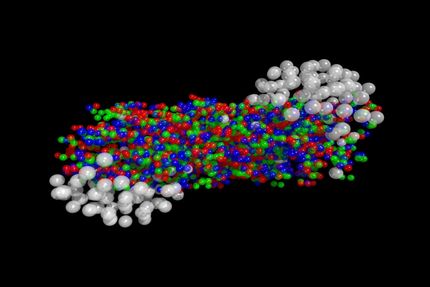Ultracold gas mimics ultrahot plasma
Duke and Brookhaven examine free-flowing 'exploding cigars'
Several years after Duke University researchers announced spectacular behavior of a low density ultracold gas cloud, researchers at Brookhaven National Laboratory have observed strikingly similar properties in a very hot and dense plasma "fluid" created to simulate conditions when the universe was about one millionths of a second old.
The plasma was formed at a colossal 2 million degrees Kelvin temperatures within Brookhaven's Relativistic Heavy Ion Collider (RHIC). The gas cloud was cooled to only .1 millionths of a degree Kelvin temperatures using a laser light "trap" and magnetic field at Duke. But both drastically different systems expanded something like exploding cigars. And their constituent matter also showed signs of flowing almost free of any viscosity - a "nearly perfect" fluid, said Duke physics professor John Thomas.
"There's about 19 orders of magnitude difference in temperature and about 25 orders of magnitude difference in density, but the commonality of both is almost zero viscosity flow," said Thomas.
In a November, 2002 report in the research journal Science, Thomas and co-researchers described what happened after they confined a cloud of lithium-6 atoms and cooled them to 100 billionths of a degree above absolute zero. When the ultracooled, cigar-shaped cloud was then released from the trap, it expanded "anisotropically," meaning "fastest along the direction that was initially narrow," he recalled.
Lithium atoms are of the fermion class, meaning that that their spin-states normally make them keep more of a distance from each other than their chummier counterpart class of atoms - the bosons. But under the extreme conditions of his experiments, even fermions find ways to collide to form what are called "strong interactions," he said.
Brookhaven's RHIC is designed to smash gold atoms together near the speed of light. Its goal is to create energies colossal enough to break apart their nuclei into an ultrahot gas of the most fundamental particles, "naked" quarks and gluons. Theoreticians believe such a "quark-gluon plasma" has not existed since a split-second after the Big Bang.
As the results of those experiments began to surface in April, 2005, RHIC experimenters found that "the cigar shaped plasma looked very much like the cigar- shaped cloud in our trap," Thomas said. That cloud also expanded anisotropically in keeping with what theorists in the field had predicted. Researchers also found that this plasma behaved as an almost-perfect fluid. Meanwhile, further work by Thomas's group has documented almost viscosity-free fluid states in its cold fermion gases.
Thomas noted that quarks themselves are also fermions. "So there's quite a broad overlap, and a genuine common interest in these two patterns. We don't have exactly the same system as at RHIC. But in a broad sense there are similarities that could be exploited to get some insight."
Meanwhile, researchers involved in string theory have also approached Thomas about similarities between his fermion findings and the predicted behavior of what those theorists call "strongly interacting quantum fields," he said. "It's not clear, though, that the prediction has any relevance to Fermi atoms colliding in a trap. However, the closeness of the initial cold gas measurements to the predictions is striking."
Elements of string theory aim at bridging the gap between quantum mechanics and general relativity by proposing that the true fundamental particles are actually ultra-tiny strings vibrating in multiple dimensions.
Most read news
Other news from the department science

Get the chemical industry in your inbox
By submitting this form you agree that LUMITOS AG will send you the newsletter(s) selected above by email. Your data will not be passed on to third parties. Your data will be stored and processed in accordance with our data protection regulations. LUMITOS may contact you by email for the purpose of advertising or market and opinion surveys. You can revoke your consent at any time without giving reasons to LUMITOS AG, Ernst-Augustin-Str. 2, 12489 Berlin, Germany or by e-mail at revoke@lumitos.com with effect for the future. In addition, each email contains a link to unsubscribe from the corresponding newsletter.





























































